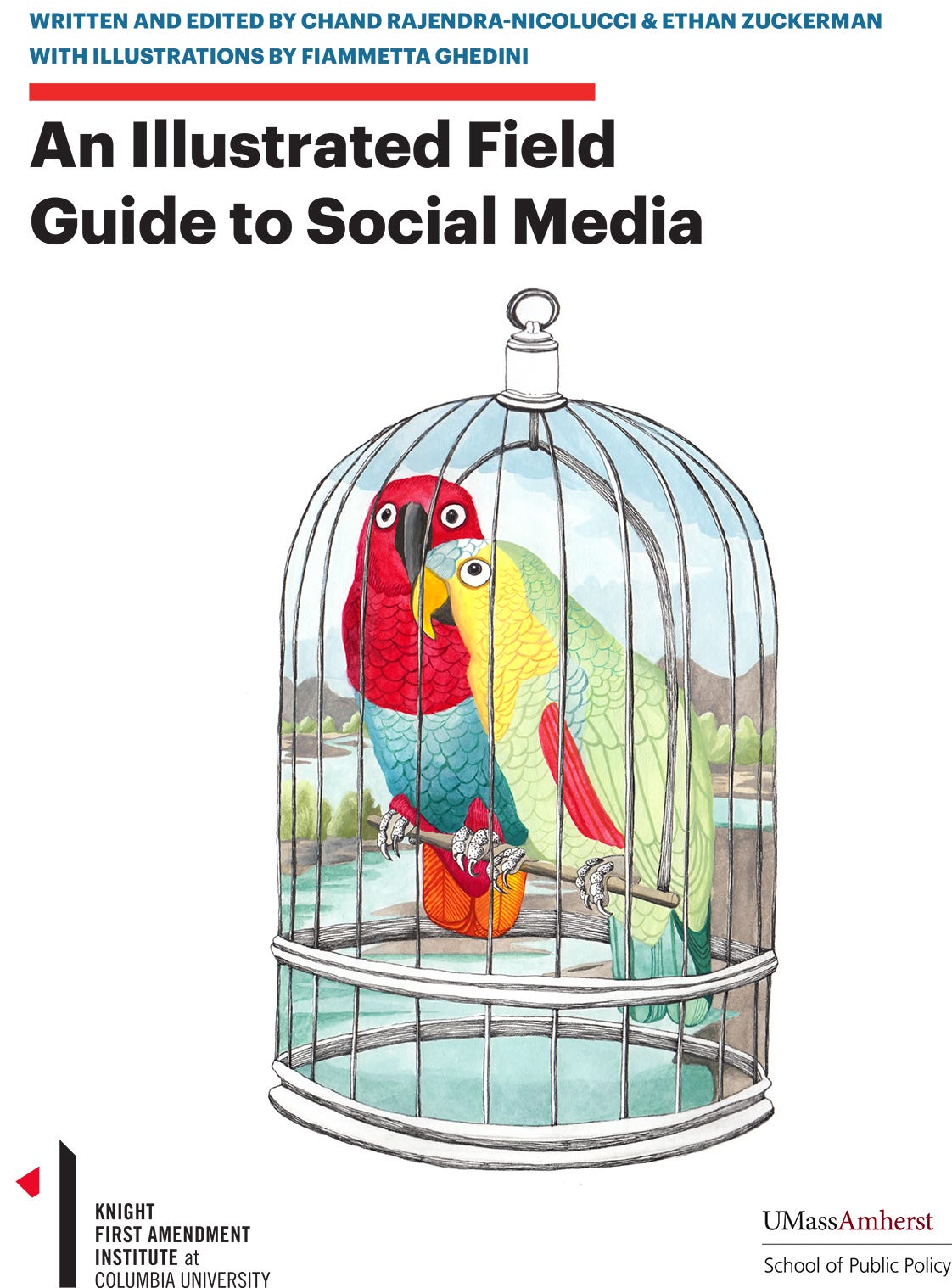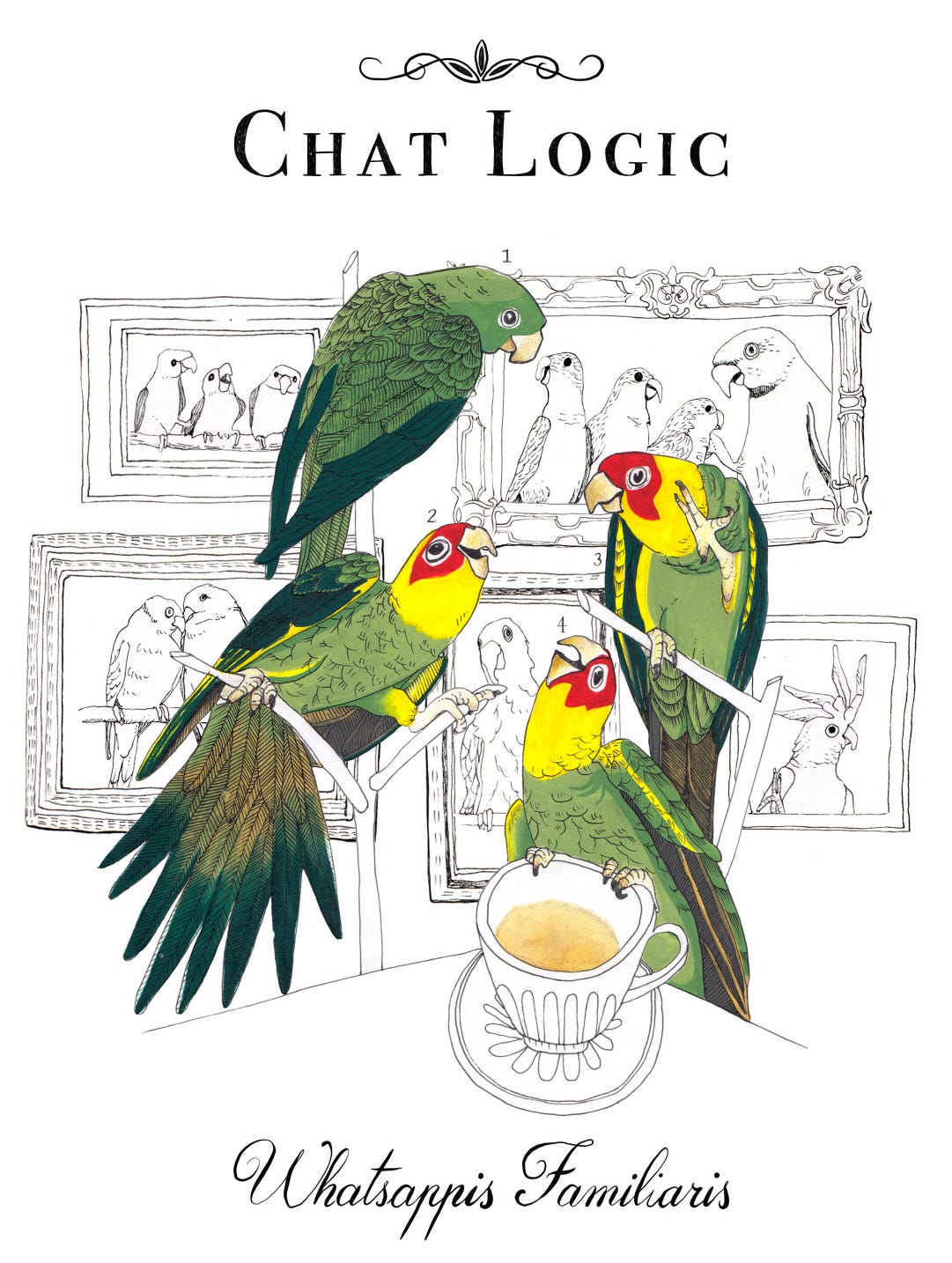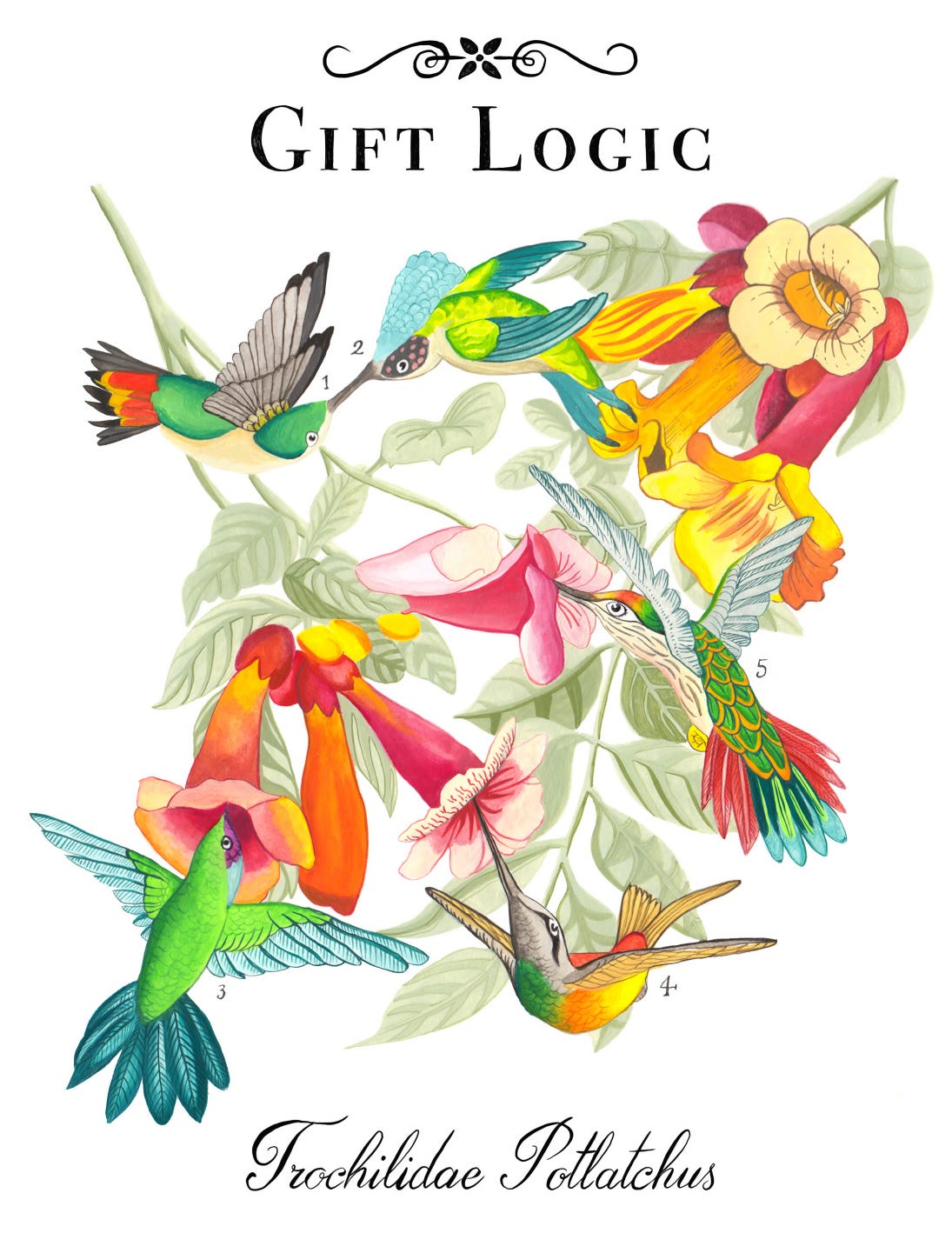🦜A Field Guide to Social Media
Ethan Zuckerman and Chand Rajendra-Nicolucci pen a path of exploration.
In the last year, bird watching has surged in popularity due to the pandemic. So it feels like no surprise that Ethan Zuckerman’s latest project An Illustrated Field Guide to Social Media uses birds and birdwatching as a helpful metaphor to the colorful spectacles we see online. The 176-page guide — brought about through The Knight First Amendment Institute at Columbia University — is a helpful reminder that birds of a feather flock together but that each flock is motivated differently. Zuckerman writes, “We tend to assume that all social media operate in the same way and suffer from the same problems.”
The guide, co-written by Chand Rajendra-Nicolucci, explores social media through many angles from business models, technical affordances, communities, norms, and more. Much like field guides that allow you to identify the birds you encounter in your hikes through the woods, Zuckerman and Rajendra-Nicolucci hope their exploration of 13 social media logics might cause you to look at the platforms and their functions with new perspective. Social media and the humans who use it are vastly more complex and diverse than our public conversations let on. As much as an American crow and a Common raven might look similar, their behaviors are incredibly distinct.
Weeks might go by where you only notice pigeons and starlings, but rest assured there are hundreds of bird species in any given habitat. The same is true for digital platforms. Zuckerman writes, “There is a diverse space of social media outside of the shadow of the major platforms and we believe it is there where the key to a different future lies.”
The field guide is especially enjoyable with the illustrative flourishes of Fiammetta Ghedini creating new specimens of birds for this analysis. Below, we picked three paths to survey. We excerpted and in some cases paraphrased text for brevity. To read the entire project click here.
The Field Guide Abridged
Chat Logic: When you want a living room, not a town square
Intro: Many people prefer the intimacy of communicating one-on-one or with a few friends and family. Think about where you go to comment on breaking news, joke with friends and family, and share photos from your weekend. Increasingly, it’s apps like WhatsApp, Discord, iMessage, and Snapchat. Our digital town squares — Facebook, Twitter, YouTube — look more like our offline town squares: performative, dominated by elites, and subject to constant political contestation. Meanwhile, “living room” interactions that used to take place in digital town squares have migrated to chat apps. The most important features of “chat logic” are privacy, ephemerality, and community governance.
Anecdote: In Africa, alternative WhatsApp clients that are created by reverse-engineering WhatsApp are actually more popular than Facebook. This is a great example of adversarial interoperability, which is explained by Cory Doctorow as “when you create a new product or service that plugs into the existing ones without the permission of the companies that make them.”
Implications: Chat platforms that cater to larger groups such as Discord and Slack want the ability to enforce rules centrally. They maintain large chat histories that can’t be stored on a user’s device, so they tend to use the cloud. Chat platforms that are intended for smaller groups and one-on-one communication like WhatsApp or iMessage emphasize user privacy and have small footprints, so they usually store messages locally and use end-to-end encryption. In some cases, like Signal, the end-to-end encryption is the key selling point for the whole system.
Pros:
There isn’t an easily accessible public archive of your messages that could be used against you.
Some chat platforms are trying to stop living rooms from turning into de facto public squares by limiting their size and virality.
Cons:
People can be “ghosted,” removed from chats, and blocked for a number of reasons, but there is rarely a formal code of conduct for what speech is permitted or banned.
Larger group chats suffer from many of the same content moderation problems traditional social media faces.
Decentralized Logic: What if social media worked more like email?
Intro: Decentralized platforms are worth a close look in the wake of the controversy over Twitter and Facebook’s reactions to a New York Post article about Hunter Biden. Twitter prevented people from linking to the Post article and locked accounts of those who posted links. It later backed down from this stance, changing a policy on hacked materials. Instead of one company dictating the rules for everyone, on decentralized social media a wide array of instances would have reacted in their own ways.
Anecdote: A lawyer named Sanjay Hegde had his account suspended twice by Twitter. It sparked a discussion about Twitter’s moderation practices in India. Many argued the platform discriminated against minorities, particularly Dalits (formerly Untouchables), citing suspensions for activists and writers. Yet the platform allowed posts by Hindu nationalists like #BoycottAllMuslims. A number of Indian Twitter users shifted to mstdn.social, a server on Mastodon, a decentralized alternative to Twitter.
Implication: A group finds dominant platforms unsuitable (often due to bans) and decides to migrate to an alternative that promises autonomy — is a common way users migrate to decentralized social media platforms like Mastodon. Mastodon is an example of “decentralized” logic.
How it works: This group of platforms uses decentralized technology such as federation or peer-to-peer protocols. Federation means that users interact with an external server like when you use Twitter or Facebook, but instead of being limited to a single company anyone can run a server that interoperates with the network, giving users more providers to choose from. Peer-to-peer protocols make everyone’s device a server, completely decentralizing the network.
Pros:
Decentralized technology means that these platforms emphasize autonomy and privacy.
There is no central entity that controls user data, meaning centralized governance and surveillant advertising in the tradition of Facebook are essentially impossible.
Cons:
Finding sustainable revenue models for decentralized platforms is an open problem and a significant barrier to growth and sustainability.
Developers need incentives to create compelling platforms and, because decentralization (along with the entrenched positions of the dominant platforms) effectively rules out targeted advertising, new revenue models will have to emerge that can support sustainable growth.
Gift Logic: Labors of love flourish online under fandom’s social norms
Intro: Fandom represents a long-standing “labor of love” culture that has existed since before the community moved online, dating back to Star Trek fandom and printed zines in the 1960s. Media scholar Francesca Coppa offers a definition of fanfiction that includes not only rewriting and transforming stories written by others, but also “written within” a fandom community, describing it as “a case study in community production and reception.”
Anecdote: In 2007, a group of male venture capitalists founded FanLib, a commercial platform that sought to monetize fanfiction production. Backlash was swift, and the platform shut down by 2008. Henry Jenkins described their underlying misstep: “FanLib had done its homework by the standards of the VC world. They simply hadn’t really listened to, talked with, or respected the existing grassroots community which surrounded the production and distribution of fan fiction.” They broke the rules of engagement by misreading “community” as “commodity.”
Implication: This dynamic sparked the establishment of the nonprofit Organization for Transformative Works (OTW), and the design and creation of Archive of Our Own (AO3), a fanfiction archive that hosts over 3.5 million registered users and over 7.5 million individual works. AO3 is a rare example of a technology being developed entirely by the community it serves, made up primarily of underrepresented groups in computing (i.e., women and LGBTQ+ people). AO3 decided they would have to “grow their own,” and fans learned to code in order to contribute to the archive’s development.
How it works: AO3 includes mechanisms to tag works explicitly as gifts for individuals and to tag works as “inspired by” other works, enabling credit. There is extensive support for fanfiction exchanges, which are a core part of fandom gifting culture, and which previously required a huge amount of manual labor to organize.
Pros:
Most online fandom spaces (including AO3) are far more prosocial than we tend to think of online communities as a whole.
AO3 is a noncommercial platform without advertising or any other business model; it operates entirely on donated money and time.
Cons:
Positive comments on stories are an important part of the gift culture and “payment” in credit. When AO3 implemented a “kudos” button that functions much like a “like” button on social media platforms, many users felt that this design choice disincentivized thoughtful comments, thus shifting fandom towards consumption over engagement.
This community’s strong social norms do at times fail and community values are contested.
Birdwatching

More Birds
Rita Dove, Pulitzer Prize winner and former U.S. Poet Laureate, reads Ingeborg Bachmann’s poem “My Bird” for The Paris Review’s “Poets on Couches”.
WE ARE HIRING!
Join a team of optimists imagining a better Internet for us all. We are seeking a part-time Staff Writer to help us round out this newsletter. Click here to learn more!
Write charmingly about interesting stuff
Flexible hrs/location, competitive pay
Build a more equitable and democracy-friendly Internet
Work with nice people
The New_ Public team
Illustrations by Fiammetta Ghedini
Civic Signals is a partnership between the Center for Media Engagement at the University of Texas, Austin, and the National Conference on Citizenship, and was incubated by New America.





